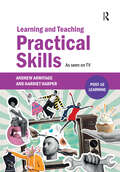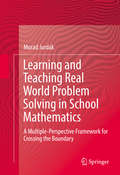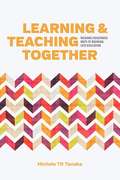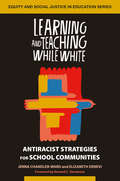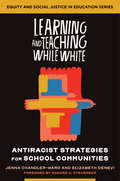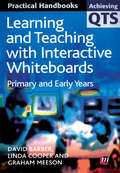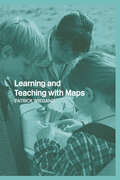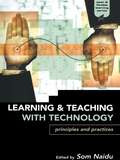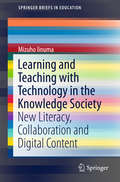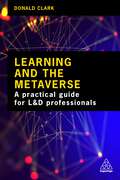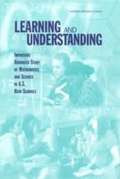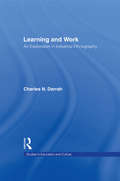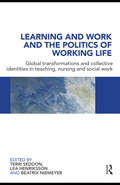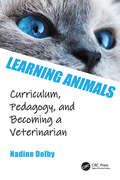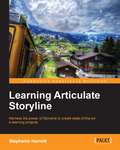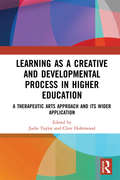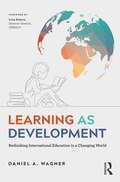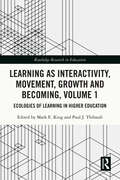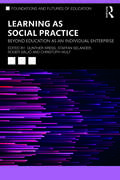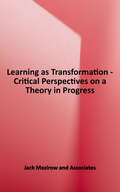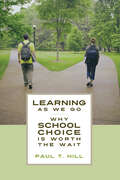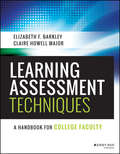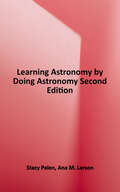- Table View
- List View
Learning and Teaching Practical Skills: As seen on TV (Further Education)
by Andrew Armitage Harriet HarperThis book combines the unique and unlikely duo of popular TV shows and pedagogy to help teachers and trainers support their students' skills development. Aimed at post-16 teachers, educators, and trainers of all vocational and technical disciplines, it encourages readers to relate the examples from popular culture and TV to their teaching toolkit. It is aligned to the Occupational Areas 1-8 within the new Diploma in FE, and is also suitable for those doing the Apprenticeship in FE teachingThe book uses examples from famous reality TV shows to reflect on how people learn practical skills such as baking, dancing, ice skating, sewing and pottery. Discussing everyday examples from TV with which readers may be familiar provides an innovative and engaging starting point to explore all aspects of teaching and learning a skill - including observation, demonstration, practice, feedback and assessment. It encourages readers to think about TV shows such as Masterchef, Bake Off and Strictly Come Dancing from the point of view of the teacher. The unique mix of seemingly low-brow popular culture combined with serious pedagogy offers key insights for learning and teaching, including critical discussion of topics such as inclusion and the value of formative feedback. Teachers and trainers will develop their own knowledge and skills to support the practical skills development of their students.
Learning and Teaching Primary Science
by Angela FitzgeraldLearning and Teaching Primary Science brings primary science to life through the stories and experiences of pre-service and practising teachers. It explores the roles of the teacher and the learner of science and examines major issues and challenges, including: engaging diverse learners, utilising technology, assessment and reporting, language and representation, and integration in the 'crowded curriculum'. Each chapter contains examples, activities and reflective questions to help readers create relevant and meaningful lesson plans. Dedicated chapters for the areas of chemistry, physics, biology and earth and environmental science will give confidence to those without a science background. Practical strategies and skills are underpinned by relevant theories and evidence-based research. Written by experts from Australia and New Zealand, Learning and Teaching Primary Science is an essential resource for those beginning their journey of teaching science in the primary school classroom.
Learning and Teaching Real World Problem Solving in School Mathematics
by Murad JurdakThe ultimate aim of this book is to identify the conceptual tools and the instructional modalities which enable students and teachers to cross the boundary between school mathematics and real world problem solving. The book identifies, examines, and integrates seven conceptual tools, of which five are constructs (activity theory, narrative, modeling, critical mathematics education, ethnomathematics) and two are contexts (STEM and the workplace). The author develops two closely linked multiple-perspective frameworks: one for learning real world problem solving in school mathematics, which sets the foundations of learning real world problem solving in school mathematics; and one for teaching real world problem solving in school mathematics, which explores the modalities of teaching real world problem solving in school mathematics. "The book is composed as, on the one hand, a high-level theoretical scholarly work on real world problem solving in school mathematics, and, on the other hand, a set of twelve narratives which, put together, constitute a thought-provoking and moving personal and professional autobiography. " - Mogens Niss "These narratives combine aspects of Murad's personal trajectory as an individual with those points in his professional career at which he became aware of perspectives on and approaches to mathematics education that were both significant in and of themselves, and instrumental for the specific scholarly endeavor presented in the book. " - Mogens Niss
Learning And Teaching Together: Weaving Indigenous Ways Of Knowing Into Education
by Michele Td TanakaTeachers unfamiliar with Aboriginal approaches to learning are seeking ways to respectfully weave Aboriginal content into their lessons. This book introduces an indigenist approach to education. It recounts how pre-service teachers immersed in a crosscultural course in British Columbia began to practise Indigenous ways of knowing. Working alongside Indigenous wisdom keepers, they transformed earth fibres into a mural and, in the process, their own ideas about learning and teaching. By revealing how these students worked to integrate Indigenous ways of knowing into their practice, this book opens a path for teachers to nurture indigenist crosscultural understanding in their classrooms.
Learning and Teaching While White: Antiracist Strategies for School Communities (Equity and Social Justice in Education Series)
by Jenna Chandler-Ward Elizabeth DeneviWe need to name whiteness, in order to move toward antiracism. For too long, white educators have relied on people of color to make change to a relentlessly racist school system. Racial equity will not come until white educators recognize their role in supporting racist policies and practices, and take responsibility for dismantling them. Learning and Teaching While White is an accessible guide to help white educators, leaders, students, and parents develop an explicit, skills-based antiracist practice. Through their own experiences working with school communities, and the strategies and tools they have developed, Jenna Chandler-Ward and Elizabeth Denevi share how white educators can gain greater consciousness of their own white racial identity; analyze the role of whiteness in their school systems; rethink pedagogical approaches and curricular topics; address the role of white parents in the pursuit of racial literacy and equity; and much more. Their book will empower white educators to be part of creating a more equitable educational system for all students.
Learning and Teaching While White: Antiracist Strategies for School Communities (Equity and Social Justice in Education #0)
by Jenna Chandler-Ward Elizabeth DeneviWe need to name whiteness, in order to move toward antiracism. For too long, white educators have relied on people of color to make change to a relentlessly racist school system. Racial equity will not come until white educators recognize their role in supporting racist policies and practices, and take responsibility for dismantling them. Learning and Teaching While White is an accessible guide to help white educators, leaders, students, and parents develop an explicit, skills-based antiracist practice. Through their own experiences working with school communities, and the strategies and tools they have developed, Jenna Chandler-Ward and Elizabeth Denevi share how white educators can gain greater consciousness of their own white racial identity; analyze the role of whiteness in their school systems; rethink pedagogical approaches and curricular topics; address the role of white parents in the pursuit of racial literacy and equity; and much more. Their book will empower white educators to be part of creating a more equitable educational system for all students.
Learning and Teaching with Interactive Whiteboards: Primary and Early Years (Achieving QTS Practical Handbooks Series)
by David Barber Linda Cooper Mr Graham MeesonInteractive Whiteboards (IWBs) are becoming increasingly common in schools and early years settings, and it is important for trainees to be equipped with the necessary skills and understanding to use them effectively to enhance learning. This book takes a thematic approach, examining all the key issues required to get the most out of this versatile learning technology. All chapters contain case studies from a range of subject areas and across the key stages, ensuring the text is rooted in the reality of the primary classroom and its curriculum.
Learning and Teaching with Maps
by Patrick WiegandA comprehensive and authoritative account of how primary school children and teachers can use maps to enhance learning and deepen understanding of this essential skill. It includes all aspects of map use, such as reading and interpreting maps and using maps to find the way, covering maps of all scales, including globes and atlases. The text is extensively illustrated with examples, including maps made by children themselves using conventional materials as well as computer software. A particular feature of the book is the integration of digital and conventional mapping, and Internet and CD-ROM cartography together with simple applications of Geographic Information Systems (GIS) appropriate to the needs of children right through primary and secondary education. This book will be of great use to all primary teachers and subject teachers in secondary school as well as non-specialist geography teachers, and will enable children to use all types of maps in new, compelling and thoughtful ways.
Learning and Teaching with Technology: Principles and Practices (Open and Flexible Learning Series)
by Som NaiduIncreased use of electronic libraries, multimedia courseware and computer-mediated communication is giving rise to an entirely new educational experience, prompting educators to assess the potential for improved and enriched learning and teaching models. This new book explores the creative opportunities offered by ICT, and provides an authoritative, rigorous survey of the ways in which ICT is currently transforming core teaching functions, including: *subject matter representation*activating learning and the engagement of students*supporting interaction and socialization*assessing learning outcomes*providing feedback to students. Written by leading experts in the field, this text draws on the experiences of practitioners at the forefront of ICT developments, making this essential reading for all educational professionals who recognize the new opportunities afforded by this changed environment. Suitable for those who are open and flexible learning specialists, educational technologists or educational developers in either a conventional or an e-learning environment.
Learning and Teaching with Technology in the Knowledge Society
by Mizuho IinumaThis book discusses learning and teaching with modern technology in the new knowledge society. It focuses specifically on new literacy and technology in classroom environments. Based on a social-constructivist approach, this book covers a wide range of new technology use examples, such as participatory media, video recording systems and 3D computer graphics. A case study on a constructivist approach to teaching and learning, especially CSCL (computer supported collaborative learning), is discussed from a practical perspective for educators. It also includes specific in-class practices with detailed accounts of curricula featuring readily accessible yet new technology available for classroom use, such as Google Sketchup 3D computer models.
Learning and the Metaverse: What this Technology Means for L&D
by Donald ClarkWhat is the metaverse? Will it really happen? How will it affect learning and development (L&D)? Where do I start?Learning and the Metaverse explains where the Metaverse came from, what it is, where it is going, debunks the myths and demystifies the jargon. It shows how it can be used to improve training and learning activities. Written by a learning technology expert with more than 35 years' experience, this book explains what this shift from 2D to 3D learning involves and what it means for you as a learning professional. It analyses the evidence for effective learning in 3D and explains what works and what doesn't. There is also guidance on designing training that can be used in the Metaverse and why it's important to consider how people learn when doing this. This book includes discussion of the Metaverse and broader education as well as coverage of virtual reality (VR), augmented reality (AR), immersive technology and learning simulations. This guide contains everything learning professionals need to know about learning and the Metaverse.
Learning And Understanding: Improving Advanced Study Of Mathematics And Science In U.s. High Schools
by Committee on Programs for Advanced Study of Mathematics Science in American High SchoolsThis book takes a fresh look at programs for advanced studies for high school students in the United States, with a particular focus on the Advanced Placement and the International Baccalaureate programs, and asks how advanced studies can be significantly improved in general. It also examines two of the core issues surrounding these programs: they can have a profound impact on other components of the education system and participation in the programs has become key to admission at selective institutions of higher education.By looking at what could enhance the quality of high school advanced study programs as well as what precedes and comes after these programs, this report provides teachers, parents, curriculum developers, administrators, college science and mathematics faculty, and the educational research community with a detailed assessment that can be used to guide change within advanced study programs.
Learning and Work: An Exploration in Industrial Ethnography (Studies in Education and Culture #8)
by Charles N. DarrahFirst published in 1996. Routledge is an imprint of Taylor & Francis, an informa company.
Learning and Work and the Politics of Working Life: Global Transformations and Collective Identities in Teaching, Nursing and Social Work
by Terri Seddon Lea Henriksson Beatrix NiemeyerLarge scale changes in work and education are a key feature of contemporary global transformations, with a pervasive politics that affects people’s experiences of workplaces and learning spaces. This thought-provoking book uses empirical research to question prevailing debates surrounding compliance at work, education and lifelong learning, and emphasises the importance of debate and dissent within the current terms and conditions of work. Examining a number of types of work, including teaching, nursing and social work, through a transnational research space, the contributors investigate how disturbances in work both constrain and enable collective identities in practical politics. Structured around three main themes, the book covers: Disturbed work: with cases of occupational reform in nursing and vocational teaching in Finland and re-regulating work in Australia Disturbing work: examining contested occupational knowledge in German school to work transitions, paraprofessional healthwork in the UK, social work in Finland, and mobilising professional expertise in US Community College faculty and Australian adult literacy Transforming politics: negotiating an ageing workforce in Germany, young adults moving through identities and careers, building a politics of ‘we’ through a global book project An enlightening collection of international contributions, this book will appeal to all postgraduate students, researchers and policy makers, in education, work, and lifelong learning.
Learning Animals: Curriculum, Pedagogy and Becoming a Veterinarian
by Nadine DolbyWe are surrounded by thousands of animals, alive and dead. They are an intimate and ever-present part of our human lives. As a society, we privilege veterinarians as experts on these animals: they are our educators and teachers in what they say, what they do, and the decisions that they make. Yet, within the field of education, there is little research on the curriculum, pedagogy, and experiences of veterinary school and students. What do veterinarians learn in veterinary school? How do their experiences during those four years shape their perceptions of animals? How do the structures, curriculum, and pedagogy of veterinary college create and influence these experiences? Learning Animals opens up this conversation through an exploration of the complicated, fascinating and often painful stories of a cohort of veterinary students as they make their four-year journey from matriculation through graduation. The book examines how the experiences of veterinary students shape how humans relate to animals, from public policy and decision-making about the environment and animals slaughtered for food, to the most personal decisions about euthanizing companion animals. The first full-length, critical, qualitative study of the perspectives of our primary teachers about animals, this will be a thought-provoking read for those in the fields of both educational research and veterinary education.
Learning Articulate Storyline
by Stephanie HarnettThis book provides one-on-one tutoring to help you quickly get up to speed with the basics while also learning how to best apply Storyline features in the context of the work you do.If you're an e-learning developer, writer, designer, subject matter expert, or all or any one of these, this book is for you. This book is not just for novices, but also for seasoned developers, transitioning from PowerPoint and Articulate Studio '09, and for those who are already working with Storyline.
Learning as a Creative and Developmental Process in Higher Education: A Therapeutic Arts Approach and Its Wider Application
by Judie Taylor Clive HolmwoodMuch has been written about the importance of creativity in learning and education over the last few decades. This unique book extends beyond the usual focus on implementing creative methods in learning, teaching and assessing within higher education, to an examination of creativity as central to a learning process which is transformational for the student. More specifically, Learning as a Creative and Developmental Process in Higher Education examines the importance of a facilitative tutor-student relationship and environment which contextualise this creative process of teaching and learning. Bringing together unique teaching and learning approaches developed by experienced academics, this book discusses a number of complex issues, including approaches to an understanding of the student’s self-concept as learner; the nature of the curriculum; the potential of metaphor and creativity; and a multi-modal approach to learning and teaching. Contributions to the book also examine some of the challenges and tensions of such an approach within the context of arts-based subjects in higher education institutions. Using a unique and coherent thematic structure that is based upon the student journey as a transformational process, this book provides a new way of understanding the student journey through higher education. Including an examination of the parallels between educational and arts education and arts therapies disciplines, this book will be of interest to researchers, academics and postgraduate students involved in the arts and the arts therapies, as well as those studying creativity in teaching and learning in higher education. It should be of particular interest to those involved in the teaching and training of teachers and lecturers in higher education.
Learning as a Generative Activity
by Logan Fiorella Richard E. MayerDuring the past twenty-five years, researchers have made impressive advances in pinpointing effective learning strategies (namely, activities the learner engages in during learning that are intended to improve learning). In Learning as a Generative Activity: Eight Learning Strategies that Promote Understanding, Logan Fiorella and Richard E. Mayer share eight evidence-based learning strategies that promote understanding: summarizing, mapping, drawing, imagining, self-testing, self-explaining, teaching, and enacting. Each chapter describes and exemplifies a learning strategy, examines the underlying cognitive theory, evaluates strategy effectiveness by analyzing the latest research, pinpoints boundary conditions, and explores practical implications and future directions. Each learning strategy targets generative learning, in which learners actively make sense out of the material so they can apply their learning to new situations. This concise, accessible introduction to learning strategies will benefit students, researchers, and practitioners in educational psychology, as well as general readers interested in the important twenty-first-century skill of regulating one's own learning.
Learning as Development: Rethinking International Education in a Changing World
by Daniel A. WagnerLearning is the foundation of the human experience. It begins at birth and never stops, a continuous and malleable link across life stages of human development. Disparities in learning access and outcomes around the world have deep consequences for income, social mobility, health, and well-being. For international development practitioners faced with today's unprecedented environmental and geopolitical pressures, learning should be viewed as a touchstone and target for those seeking to truly effect global change. This book traces the path of international development work—from its pre-colonial origins to the emergence of economics as the dominant discipline in the field—and lays out a new agenda for policymakers, researchers, and practitioners, from early education through adulthood. Learning as Development is an attempt to rethink international education in a changing world.
Learning as Interactivity, Movement, Growth and Becoming, Volume 1: Ecologies of Learning in Higher Education (Routledge Research in Education)
by Paul J. ThibaultThe two inter-linked volumes in this series are dedicated to the development of analysis and theorisation of learning and teaching in higher education. The two volumes focus on the multi-scalar ecological inter-connectedness of learners with teachers, with artefacts, with cultural patterns and resources, with places, with social activities and practices, with social institutions, with time and temporality, and with technologies. Learning reflects inter-individual dynamics that are shaped by biology and culture. Against prevailing orthodoxies that view learning in higher education in terms of "information transmission" and "content delivery," the contributors articulate leading developments in distributed cognition, distributed language, ecological psychology, enactivist and embodied-embedded cognitive science, interactivity, and multimodal event analysis. They also extend several earlier traditions such as American pragmatism, embodied curriculum theory, and Vygotsky's latter day anti-dualist Spinozan turn. Through detailed empirical analysis of in vivo episodes of learning using multimodal event analysis, cognitive event analysis, and cutting-edge theory, the authors show how and why learning is not adequately explainable as internal mental processes per se. Instead, sophisticated empirical analysis and innovative theory are put to work to reveal the emergence of learning in the interactivity of learners and teachers with the affordances of a distributed brain-body-environment learning system. Volume 1 is an edited collection of seven chapters written by internationally renowned researchers together with an Introduction and an Afterword written by King and Thibault. Volume 1 (and its successor Volume 2) will serve as valuable reading for educationalists and researchers in the cognitive, communication, learning, and language sciences who are looking for new multidimensional tools for thinking about, and new empirical tools for analysing, learning, and teaching as multi-scalar interactive processes in radical embodied ecologies of learning and teaching.
Learning as Social Practice: Beyond Education as an Individual Enterprise (Foundations and Futures of Education)
by Gunther KressThis book studies learning as a social enterprise, contextually situated, organized and assessed. It gives a broad theoretic grounding for an understanding of learning which goes beyond a common reductionist approach. The book discusses four related approaches to learning which share a social perspective: social semiotics and multimodality; a design-theoretic approach to learning; a socio-cultural perspective; and a perspective of mimetic learning. Contributing authors consider the theoretical question of how to understand educational systems, learning and social communication as historically situated practices. The chapters in this book analyze key working practices including: analyzing what learning, remembering and cognitive work is like in a practice involving different kinds of expertise; problem-solving and engaging through collaboration; learning and teaching in different formal, semi- and non-formal environments; a design-theoretic approach to learning; social semiotic perspectives on learning; the mimetic and ritual dimension of learning; how social learning can be organized to support students; how learning has been conceptualized in psychology and neighbouring research areas. This book will be of great interest to students and researchers interested in learning and meaning-making, multimodal representations and communication, designs for learning, education and teaching, and social achievement in different formal and non-formal contexts.
Learning As Transformation: Critical Perspectives on a Theory in Progress, 1st Edition
by Jack MezirowProvocative and illuminating, this book is a must-read for adult educators seeking to understand and facilitate transformational learning. It showcases a stellar group of authors who not only engage each other and the reader in constructive discourse, but who also model the heart of the transformational learning process." --Sharan B. Merriam, Department of Adult Education, University of Georgia This volume continues the landmark work begun by Jack Mezirow over twenty years ago--revealing the impact of transformative learning on the theory and practice of adult education. Top scholars and practitioners review the core principles of transformation theory, analyze the process of transformative learning, describe different types of learning and learners, suggest key conditions for socially responsible learning, explore group and organizational learning, and present revelations from the latest research. They also share real-world examples drawn from their own experiences and assess the evolution of transformative learning in practice and philosophy. Learning as Transformation presents an intimate portrait of a powerful learning concept and invites educators, researchers, and scholars to consider the implications of transformative learning in their professional work.
Learning as We Go: Why School Choice is Worth the Wait
by Paul T. HillPaul T. Hill examines the real-world factors that can complicate, delay, and in some instances interfere with the positive cause-and-effect relationships identified by the theories behind school choice. He explains why schools of choice haven't yet achieved a broader appeal and suggests more realistic expectations about timing and a more complete understanding of what must be done to make choice work.
Learning Assessment Techniques
by Elizabeth F. Barkley Claire Howell Major50 Techniques for Engaging Students and Assessing Learning in College Courses Do you want to: Know what and how well your students are learning? Promote active learning in ways that readily integrate assessment? Gather information that can help make grading more systematic and streamlined? Efficiently collect solid learning outcomes data for institutional assessment? Provide evidence of your teaching effectiveness for promotion and tenure review? Learning Assessment Techniques provides 50 easy-to-implement active learning techniques that gauge student learning across academic disciplines and learning environments. Using Fink's Taxonomy of Significant Learning as its organizational framework, it embeds assessment within active learning activities. Each technique features: purpose and use, key learning goals, step-by-step implementation, online adaptation, analysis and reporting, concrete examples in both on-site and online environments, and key references--all in an easy-to-follow format. The book includes an all-new Learning Goals Inventory, as well as more than 35 customizable assessment rubrics, to help teachers determine significant learning goals and appropriate techniques. This book also provides access to a downloadable worksheet to guide teachers through the seven steps of the Learning Assessment Techniques planning and implementation cycle. College teachers today are under increased pressure to teach effectively and provide evidence of what, and how well, students are learning. An invaluable asset for college teachers of any subject, Learning Assessment Techniques provides a practical framework for seamlessly integrating teaching, learning, and assessment.
Learning Astronomy by Doing Astronomy: Collaborative Lecture Activities, Second Edition
by Stacy Palen Ana M. LarsonResearch shows that students learn best by doing. This workbook, written by two master teachers, contains 36 field-tested activities, including nine new to the Second Edition, that span the introductory astronomy course and can be used in any size classroom. Each activity is now self-contained with an introduction that provides necessary background material for students. Activities are built around a concept that leads students from basic knowledge to a deeper understanding through guided interactions. The Second Edition is supported by Smartwork5, so instructors can easily assess student understanding.
